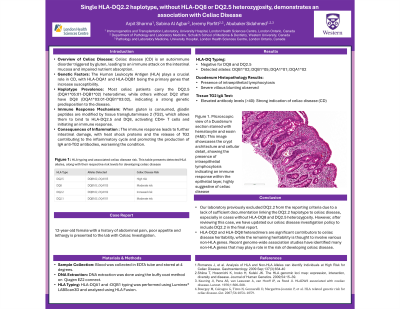Back

Single HLA-DQ2.2 haplotype, withoutHLA-DQ8 or DQ2.5 heterozygosity, demonstrates an association with Celiac Disease. Arpit Sharma,David Beaune, Abubaker Sidahme
(P514) Single HLA-DQ2.2 haplotype, without HLA-DQ8 or DQ2.5 heterozygosity, demonstrates an association with Celiac disease.
Location: Platinum Ballroom

Poster Presenter(s)
Body: Celiac disease (CD) is an autoimmune condition in which consuming gluten, a protein present in wheat, barley, and rye, prompts the immune system to attack the intestinal mucosa. This immune response causes inflammation and disrupts the absorption of nutrients from food. The Human Leukocyte Antigen (HLA) plays a pivotal role in the onset and progression of celiac disease. Specifically, the genes HLA-DQA1 and HLA-DQB1, responsible for encoding the HLA-DQ heterodimer, are the primary genetic factors that predispose individuals to CD. Around 90% to 95% of CD patients carry the DQ2 haplotype, while those lacking DQ2 often possess DQ8, underlining a significant genetic susceptibility to the disease. The most commonly associated DQ heterodimers for CD are DQ2.5 (DQA1*05:01-DQB1*02) and DQ8(DQA1*03:01-DQB1*03:02). Gliadin peptides from gluten are modified by tissue transglutaminase 2 (TG2), triggering immune responses. These peptides bind to DQ2.5 and DQ8, activating CD4+ T cells. Inflammation and signals like heat shock proteins further damage the intestine, releasing TG2, a target for IgA anti-TG2 antibodies. In a specific case involving a 12-year-old patient undergoing celiac investigation, our laboratory protocol at the time involved reporting the presence of either DQ8 or DQ2.5 haplotypes. The patient's typing for DQ did not reveal either of these markers, leading to a negative report for DQ8 and DQ2.5. The patient’s DQ typing was DQB1*02, DQB1*05, DQA1*01 and DQA1*02. Despite this, the patient exhibited intraepithelial lymphocytosis with severe villous blunting as indicated by the histopathology biopsy report. Additionally, the tissue TG2 IgA test showed elevated antibody levels (>40), strongly suggesting CD. Upon further review, it was discovered that the patient carried the DQ2.2 (DQB1*02-DQA1*02) heterodimer, which was not initially considered.
Conclusion: Previously, our laboratory omitted DQ2.2 from the reporting criteria due to insufficient documentation regarding the correlation between celiac disease and a sole DQ2.2 haplotype, particularly in the absence of HLA-DQ8 and DQ2.5 heterozygosity. However, following this case, our laboratory has revised its celiac investigation policy to incorporate DQ2.2 in the final report.
Conclusion: Previously, our laboratory omitted DQ2.2 from the reporting criteria due to insufficient documentation regarding the correlation between celiac disease and a sole DQ2.2 haplotype, particularly in the absence of HLA-DQ8 and DQ2.5 heterozygosity. However, following this case, our laboratory has revised its celiac investigation policy to incorporate DQ2.2 in the final report.

